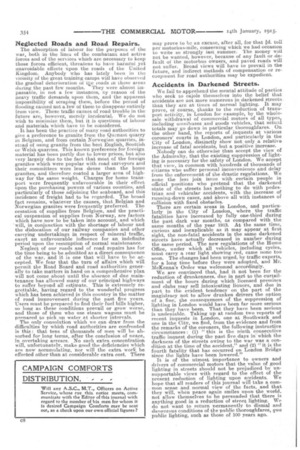Accidents in Darkened Streets.
Page 2

If you've noticed an error in this article please click here to report it so we can fix it.
We fail to apprehend the mental attitude of parties who seek to cajole themselves into the belief that accidents are not more numerous in darkened streets than they are at times of normal lighting. It may prove, of course, thanks to the reduction of trans port activity, in London for example, by the whole sale withdrawal of commercial motors of all types, including omnibuses and goods vehicles, that actual totals may go down in particular thoroughfares. On the other hand, the reports of inquests at various coroners' courts in London, and particularly in the City of London, distinctly show not only a relative increase of fatal accidents, but a positive increase. Nobody can do otherwise than accept the view of the Admiralty, that the existing suppression of lighting is necessary for the safety of London. We accept that view, in common with hundreds of thousands of citizens who suffer personal inconvenience and delay from the enforcement of the drastic regulations. We none the less join issue with certain people in official positions who pretend that the darkened state of the streets has nothing to do with pedestrian and vehicular accidents, with the increase of running-down cases, and above all with instances of collision with fixed obstacles.
There are certain areas in London, and particularly in the City of London, where the traffic fatalities have increased by fully one-third during the past dark war months, as compared with the same months of the year 1912. At the same time, curious and inexplicable as it may appear at first sight, the non-fatal accidents in the same darkened streets have actually decreased in number during the same period. The new regulations of the Home Office, under which all vehicles, including cycles, must carry a rear light showing red, came none too soon. The changes had been urged, by traffic experts, for a long time before they were adopted, and Mr. .McKenna's Order was welcomed accordingly.
We are convinced that, had it not been for the reduction of drunkenness, due in part to the curtail.. merit of the hours during which licensed premises and clubs may sell intoxicating liquors, and due in part to the evident terid.ency on the part of the magistracy not to allow drunken drivers the option of a fine, the consequences of the suppression of lighting in London would have been far more serious than they have been. That they have been serious is undeniable. Taking up at random two reports of recent inquests in London, one at Southwark and one in the City, we find, from the evidence and from the remarks of the coroners, the following instructive circumstances : (1) " this is the ninth consecutive traffic inquest during the past five days in which the darkness of the streets owing to the war was a condition at the time of the accident," and (2) "it is the fourth fatality that has occurred on London Bridge since the lights have been lowered."
Iii is of the utmost importance to owners and drivers of commercial motors that the value of good lighting in streets should not be prejudiced by unsupportable views with regard to the effect of the present reduction of lighting upon accidents. We hope that all readers of this journal will take a common sense and normal view of the facts, and that they will, when peace again smiles upon the world. not allow themselves to be persuaded that there is anything good in a reduction of street lighting. We do not want to return permanently to dismal and danaerous conditions of the public thoroughfares, qua public lighting, such as those of 100 years ago.




















